“There are only a few basic methods of playing [board] games and over the past 250 years many thousands of variations have been created. The basic methods of play come down to four types – race games, strategy games, table games and card games. Many were originally developed for adults and were later adapted for children. [..]
The Game of Goose is generally regarded as the prototype of the modern race game. Devised in Italy and taken from much early formats of games played in the Middle and Far East, it was first noted in England by John Wolfe in 1597 as “the Newe and Most Pleasant Game of the Goose”. [..]
Many of the first publishers of games were in fact cartographers and they quickly included the race game idea into game of Geography. The spiral format was not used; it was replaced by a map – of England and Wales, Scotland and Ireland (collectively or individually), of Europe or of the world.”
– ‘The Development of the English Board Game, 1770 – 1850’ by Caroline G. Goodfellow
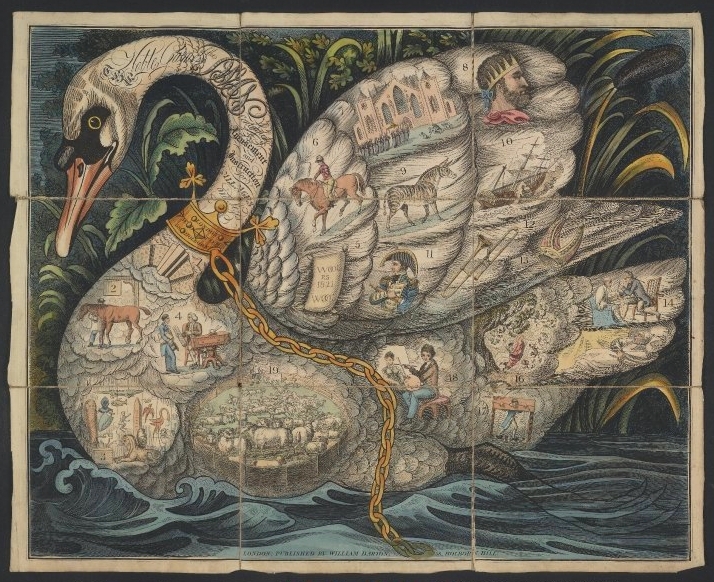
The Noble Game of the Swan – A linen-backed etching – presumably for the children of the elite – from 1821, published in London by William Darton. The nineteen compartments of the swan game board includes the British Museum (No. 3). The game board came complete with a rule book, an etching of some swans and a slip case.
As Paul K writes, except where noted, all these board game prints were sourced from the British Museum Prints Database. The captions above are quoted or were derived from the curator’s notes at the British Museum site.
I’m not a historian although I did start a history course (incomplete) some years ago. I remember reading a book about the industrial revolution and was impressed with the author’s research. Specifically, I recall that in assessing the impact of industrialisation on the quality of life in childhood they included a copy of a shire pharmacy ledger that listed sales of medicines.
The quantities of laudanum (heroin derivative) sold over a given period of time was staggering. But the really impressive aspect – just in terms of smart thinking – was that the author showed that the graph of sales of the drug correlated fairly well with the infant mortality rate. Destitute people found it cheaper to spend what little they had on a ‘medicine’ to quieten their starving children rather than buying them food. Something like two out of every three kids didn’t make it to the age of five years (that’s surely inaccurate but it’s in the ballpark range). (Later: this was not fact-checked and is, at best, only partly true.)
That little memory came back to me while I was trawling through these board game prints because, like the pharmacy ledger, the prints seem to me to contain a wealth of indirect evidence about things like customs and social status and attitudes to education and maybe a whole lot more besides. No, it’s not atom splitting and it’s perhaps quite logical to most people and second nature to historians. That doesn’t detract, for me, from the elegant thinking I see in deciding to sift through a pile of otherwise inconsequential illustrated material to learn more about history. That sort of detective work makes history more appealing, more alive somehow.
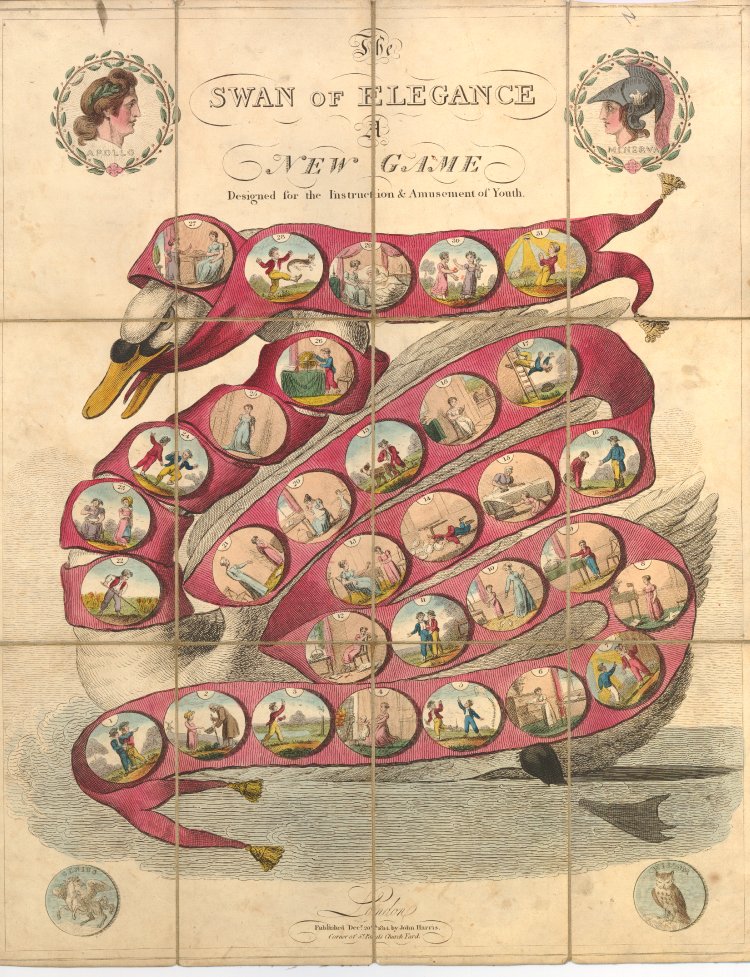
The Swan of Elegance –
A New Game Designed for the Instruction and Amuseument of Youth
John Harris published this linen-backed, hand-coloured etching in 1814. Each of the game board’s compartment shows a child engaged in a moral or an immoral deed. A twelve page rulebook had four lines of verse explaining each scene. The medaliions in each corner represent Apollo, Minerva, Wisdom and Genius.
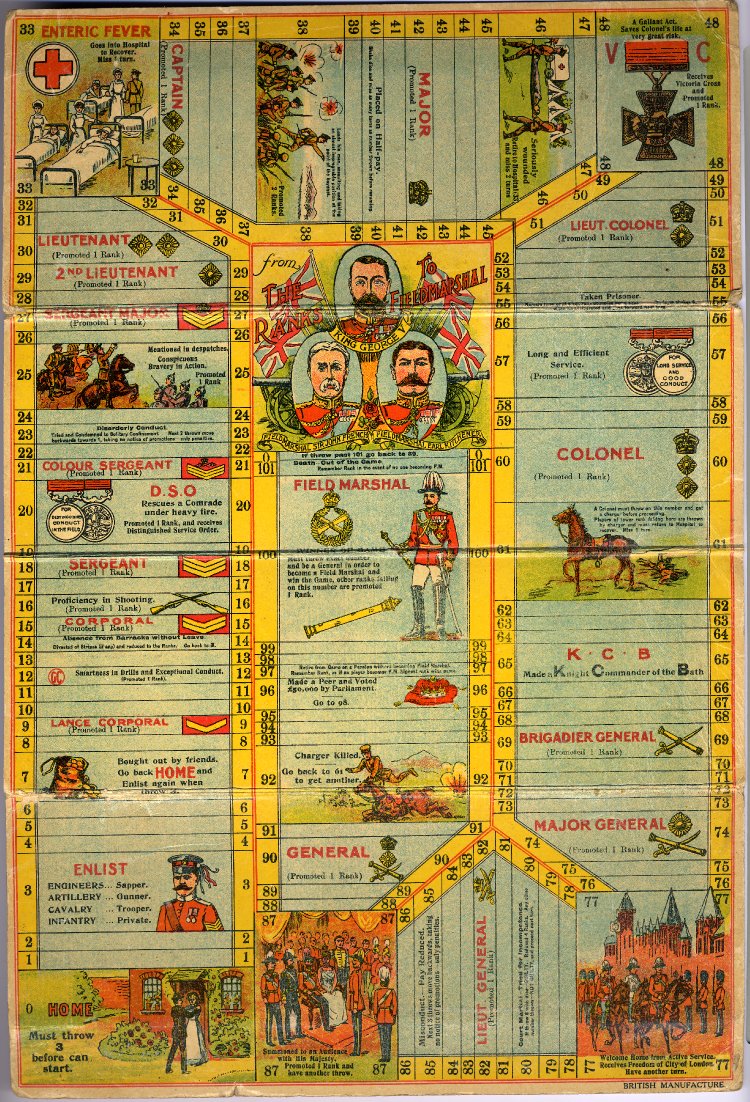
The Ranks to Field Marshall
First World War board game with portraits of George V and Field Marshals French and Kitchener. Anonymous artist. Manufactured in Britain as a process print on a board.
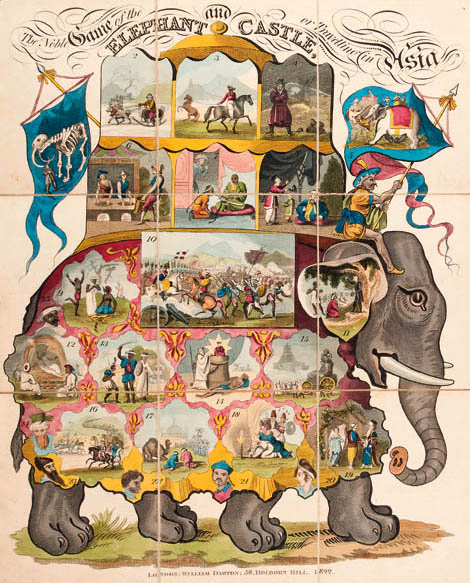
“The Noble Game of the Elephant and Castle or Travelling in Asia Combining Amusement and Instruction for Youth of Both Sexes. A hand-coloured etching and engraving mounted on linen showing an elephant with scenes of Asia on his Howdah and trappings — 19½in. (50cm.) by 15½in. (40cm.) in original slip case with coloured label showing an elephant under a palm tree, published by William Darton, 58 Holborn Hill 1822”

Neues Bilder Lotterie Spiel
(New picture lottery)
Anonymous print from about 1810 to 1820. Game-board with 80 pictorial compartments, arranged in 8 rows of 10, depicting flowers, animals characters and various objects, with instructions beneath.
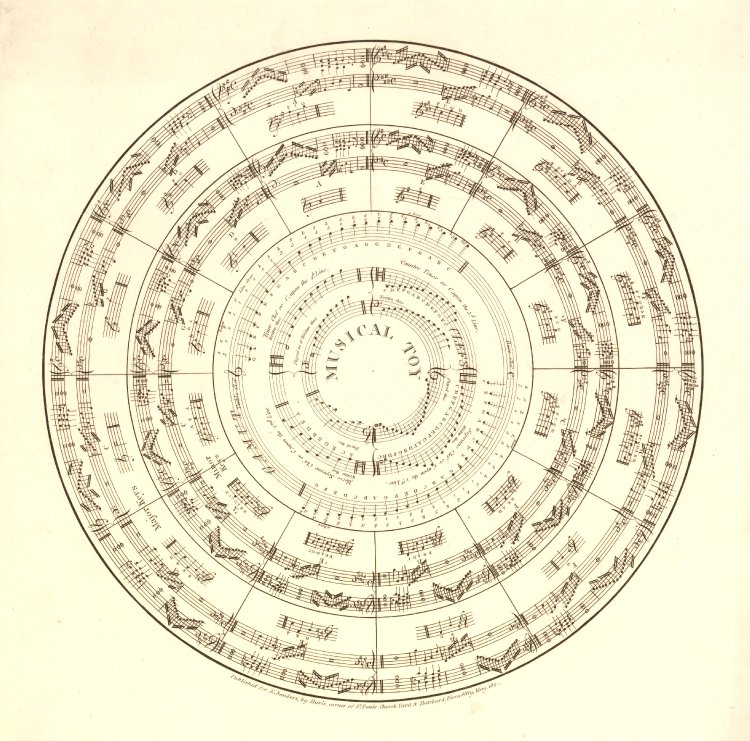
Musical Toy
Etching published by John Hatchard and John Harris in 1811. Circular game board with lines of musical notation, divided into 12 segments, with scales in the centre.
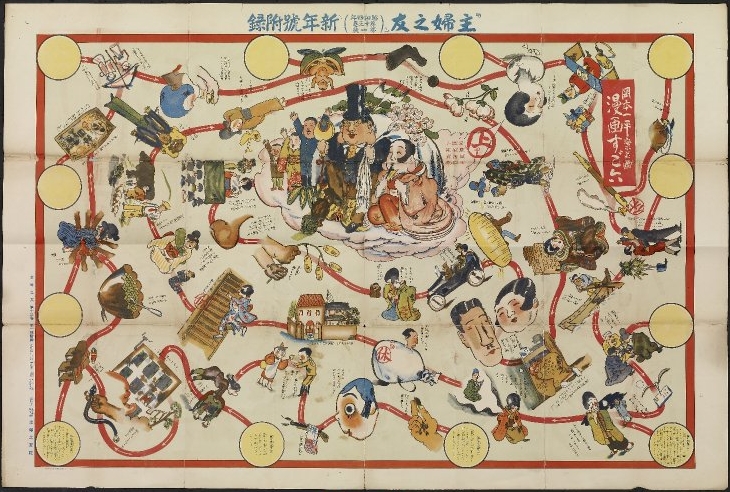
Manga sugoroku
(Manga board game)
Print artist Okamoto Ippei’s colour lithograph from 1929 featured as a supplement to the Japanese magazine, ‘Shufu no Tomo’ (Housewife’s Friend). The board game (purports to) illustrate the life choices of a young modern woman.
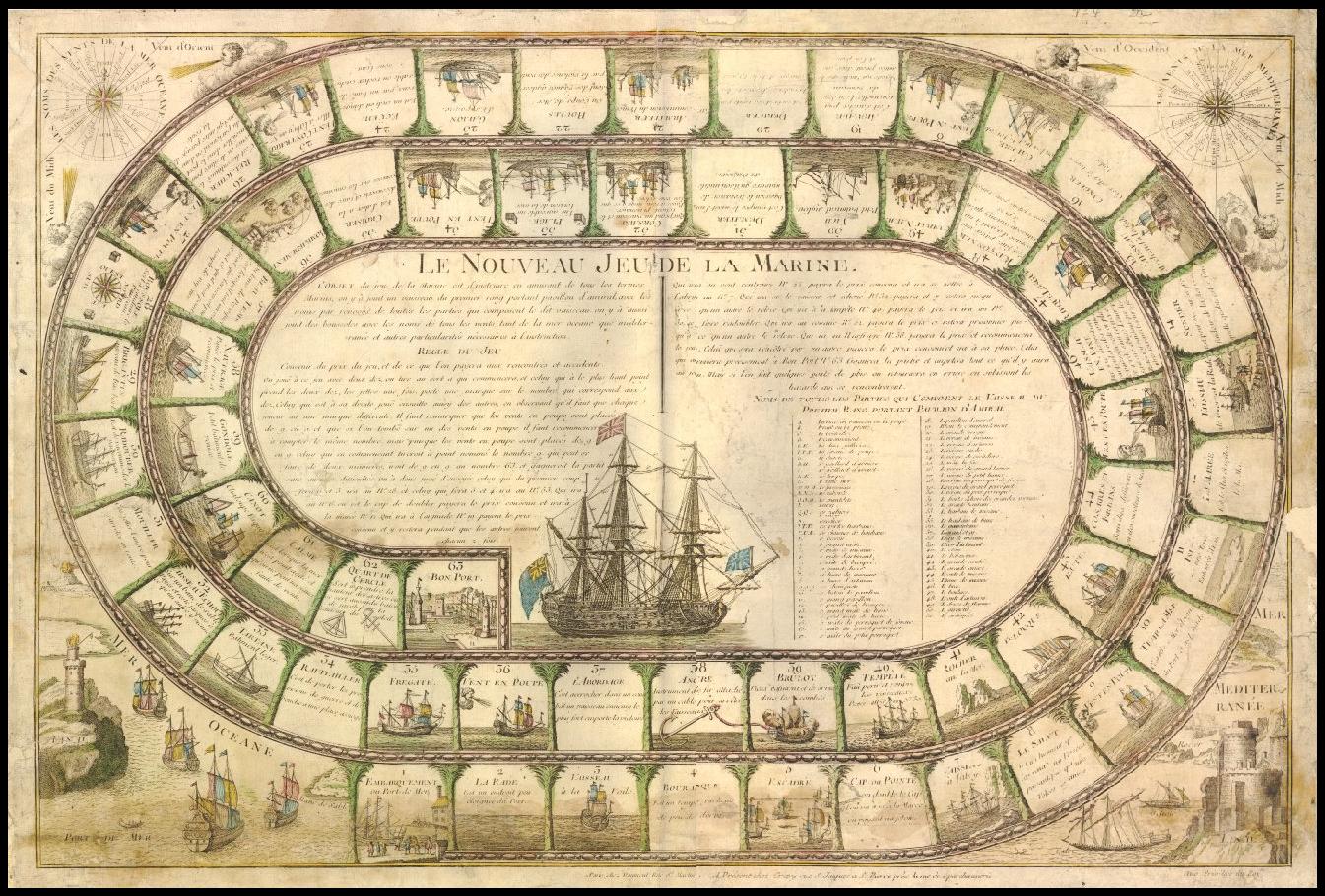
Le Nouveau jeu de la marine
(The new navy game)
[spliced together – poorly – from two aberrant halves]
Hand-coloured etching from the 1790s filled with nautical terms and associated illustrations. Perhaps the British ship in the central scene could be sunk at the end of the game? I can’t quite read the rules.

Le Jeu de Paris en Miniature
Game board etching published in 1815 by Veuve Chéreau. Features ninety numbered pictorial compartments, each depicting a shop sign in Paris, with a literal interpretation of its name, a description of what it sells and its address; the winning square is ‘Au Retour d’Astrée’; in the centre the rules.
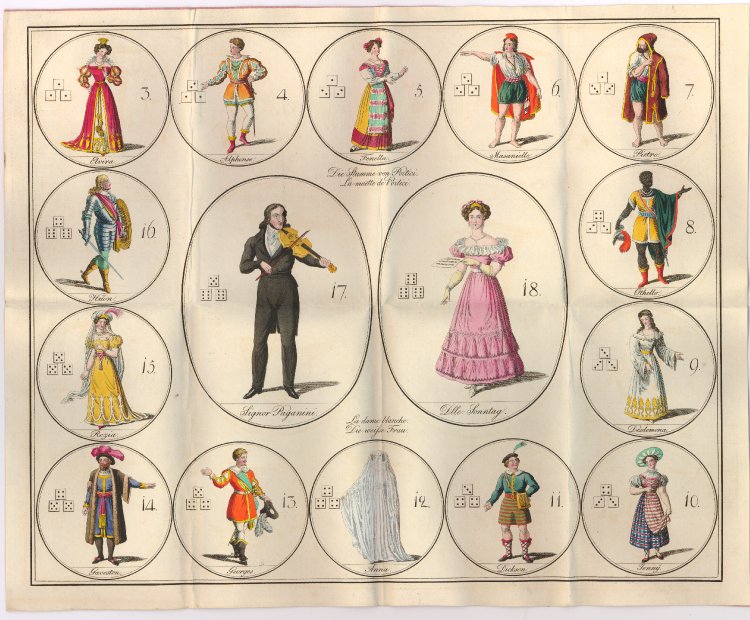
Kunst und Glück
(Art and happiness)
19th century anonymous game board etching with 16 compartments, numbered from 3 – 18, numbers 3 to 16 showing literary characters arranged in a square, with two larger central compartments, showing Dlle Sonntag and Signor Paganini. Accompanied by a letterpress rule sheet in French and German.
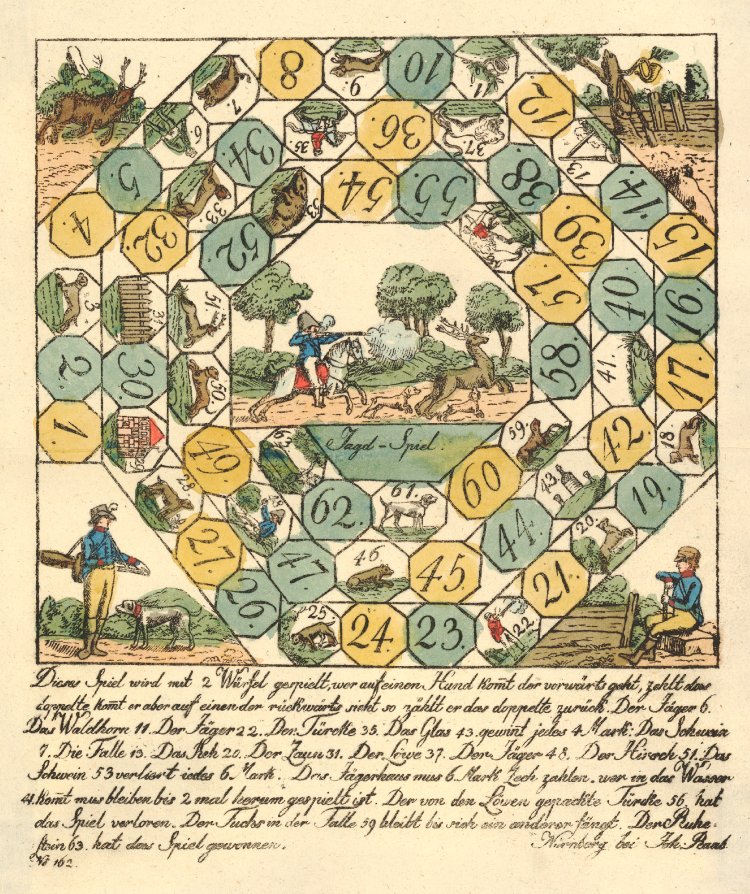
Jagd-Spiel
(Game of the hunt)
Published by Johann Raab in Nuremberg in the late 18th century, this print is described in the notes as a hand-coloured lithograph. I think it’s more likely a woodblock print, given the fairly unsophisticated quality and the fact that lithography was only invented in 1796. *shrug*
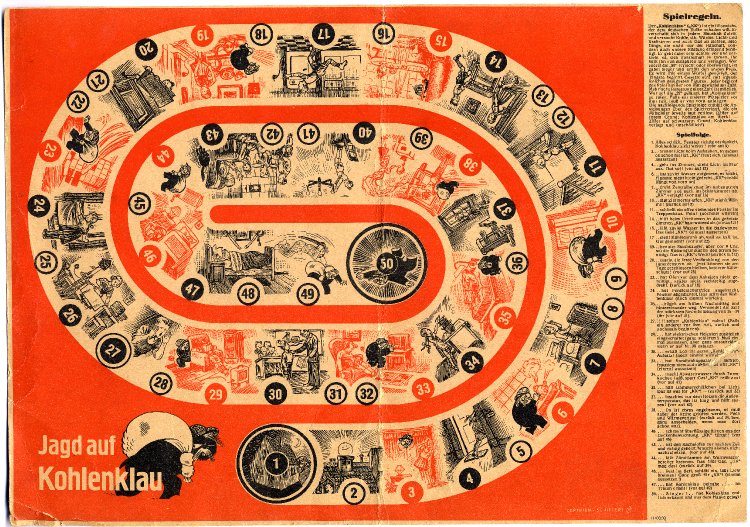
Jagd auf Kohlenklau
(Hunt the Coal Thief)
Very rare propaganda board game print published by Lepthian-Schiffers in the 1930s that sought to promote economy in the use of raw materials in Germany.
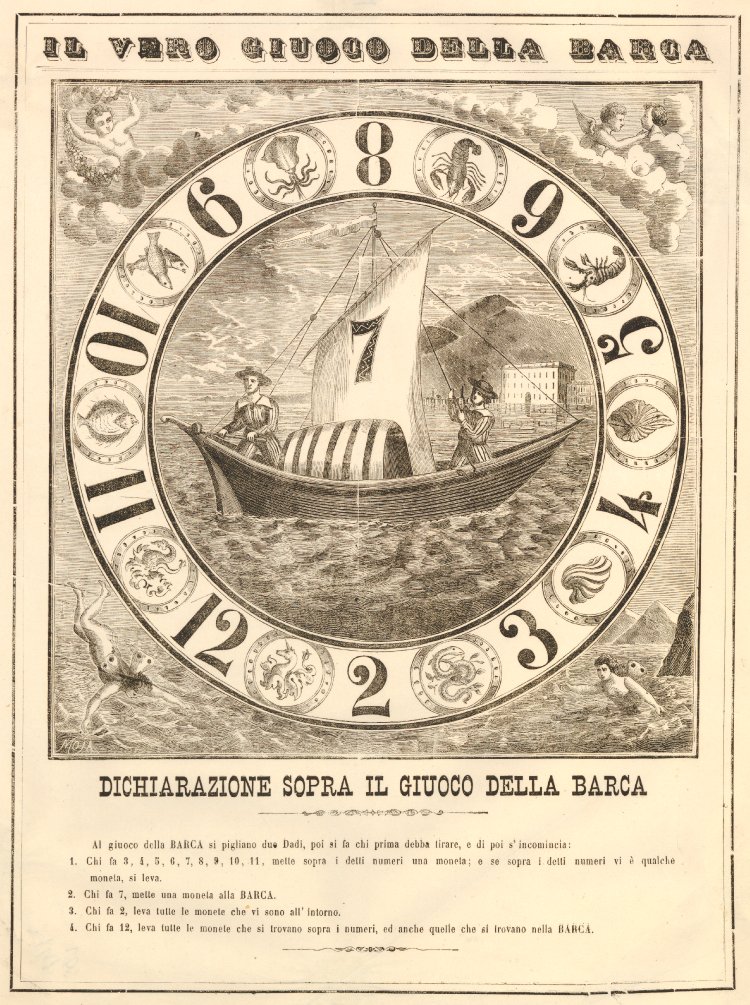
Il Vero Giuoco della Barca
(The True Game of the Boat)
Anonymous late 19th century game board lithograph of two sailors in a boat within a ring bearing numbers and shellfish. There are putti in each corner of the board and letterpress instructions beneath
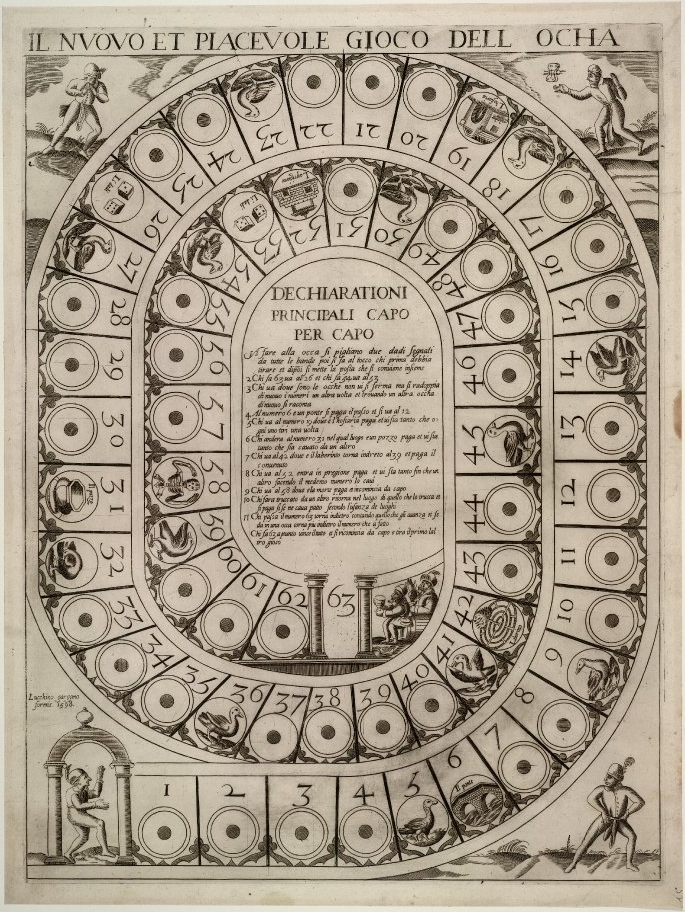
Il nuovo et piacevole gioco dell ocha
(The new and enjoyable game of the goose)
Engraving published by Lucchino Gargano in 1598 with the game rules in the centre and pictures of fools in each corner.
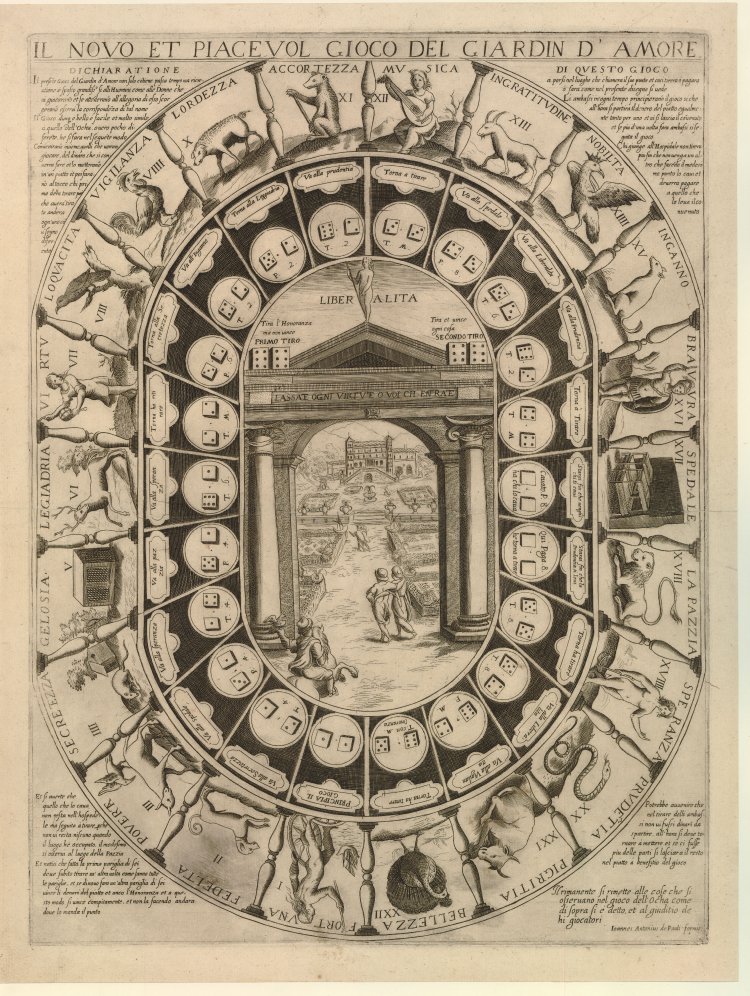
Il novo et piacevol gioco del giardin d’amore
(The new and enjoyable game of the garden of love)
Published by Giovanni Antonio de Paoli in the 1590s, the board features two rows of game squares, the outer one displaying the virtues and the one closer to the central garden with game numbers on pairs of dice.
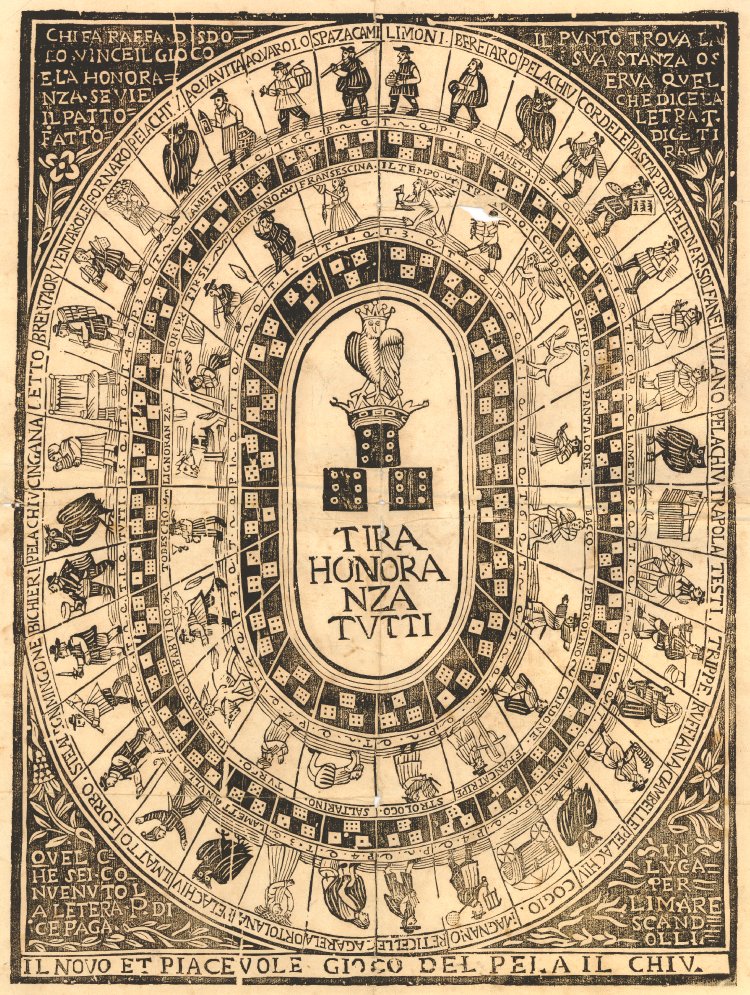
Il novo e piacevole gioco del pela il chiu
(known as: ‘pluck the owl’)
Humans and owls make up the majority of figures in the four concentric rings surrounding a crowned owl atop a ‘triple six’ of dice. The inscription language suggests the creator of this anonymous 18th century print comes from the north east of Italy and it may have been published in Parma by Giovanni Battista Panzera. The ‘t’ and the ‘p’ below the compartmented figures refer to the number of quattrini (‘q’) that a player was awarded or had to pay out. Evidently it was a popular game: prints were still being published well into the 19th century. Generally speaking, people purchased their games as prints on paper and fastened them to a board or a hard surface in their own home (ie. this was the case for the majority of game boards: it’s obviously cheaper to buy them unmounted)
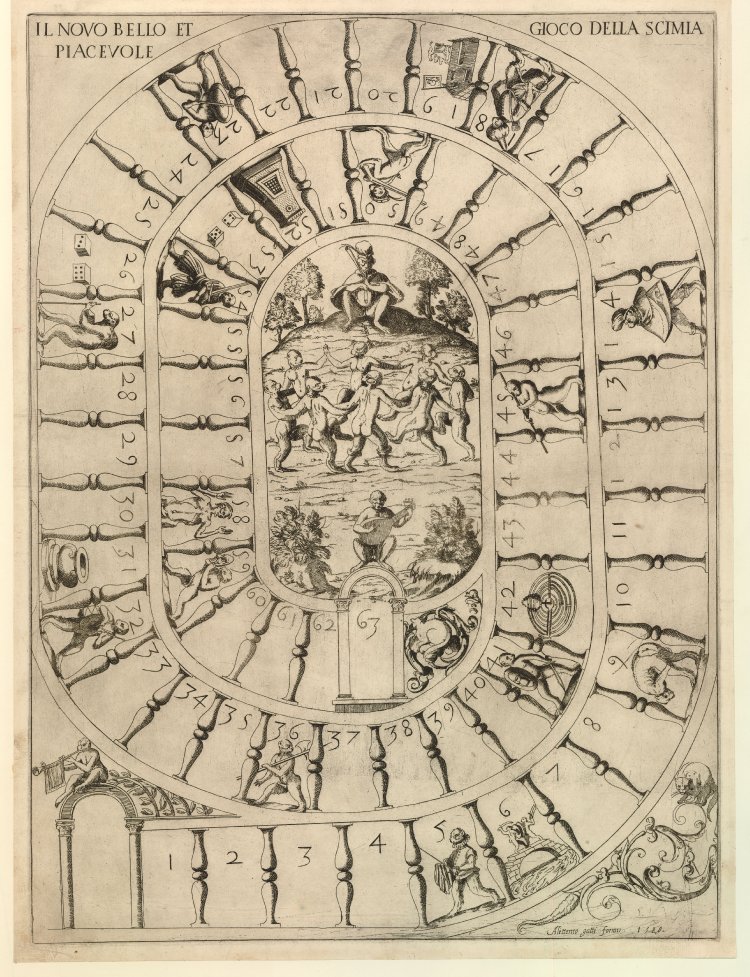
Il novo bello et piacevole gioco della scimia
(The new beautiful and enjoyable game of apes)
Etching published by Altiero Gatti in 1588 featuring numerous monkeys displaying human characteristics.

Il Dilettevole Gioco del’ Oca
(The Delightful Game of the Goose)
Anonymous 18th century board game print from Bologna with corner drawings of (what appear to be) Commedia dell’Arte figures and a central couple eyeing the goose hungrily. As with the majority of the goose games, this board has sixty three numbered playing fields.
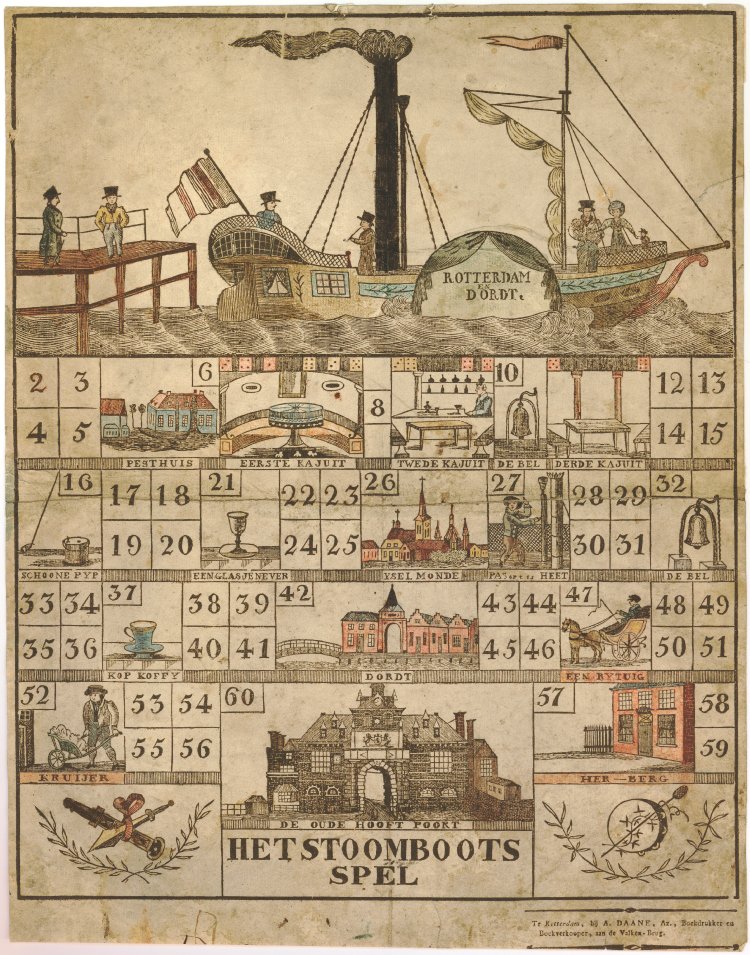
Het Stoomboots Spel
(The steamboat game)
Dutch design published in Paris by A. Daane between 1810 and 1825. The covering of the paddle wheel bears the steamboat’s name or the cities between which it operated, ‘Rotterdam en Dort.’ (Dort or Dordt is the informal name of the city of Dordrecht).
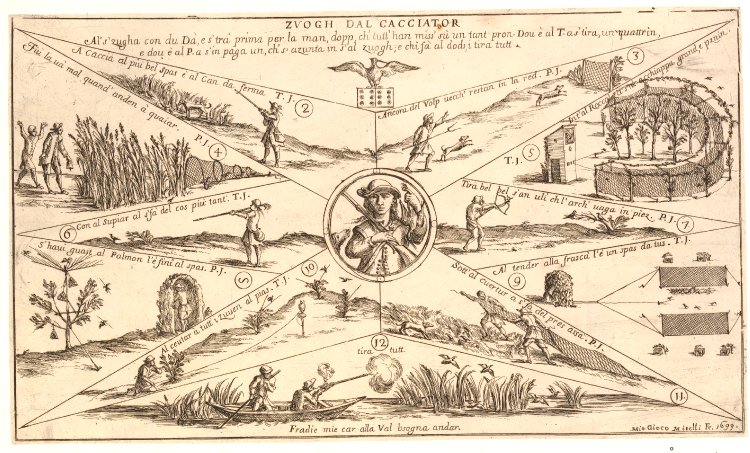
Zuogh dal cacciator
(? [..] hunters)
Another Giuseppe Maria Mitelli print, dated 1699. There are eleven bird hunting scenes depicted.
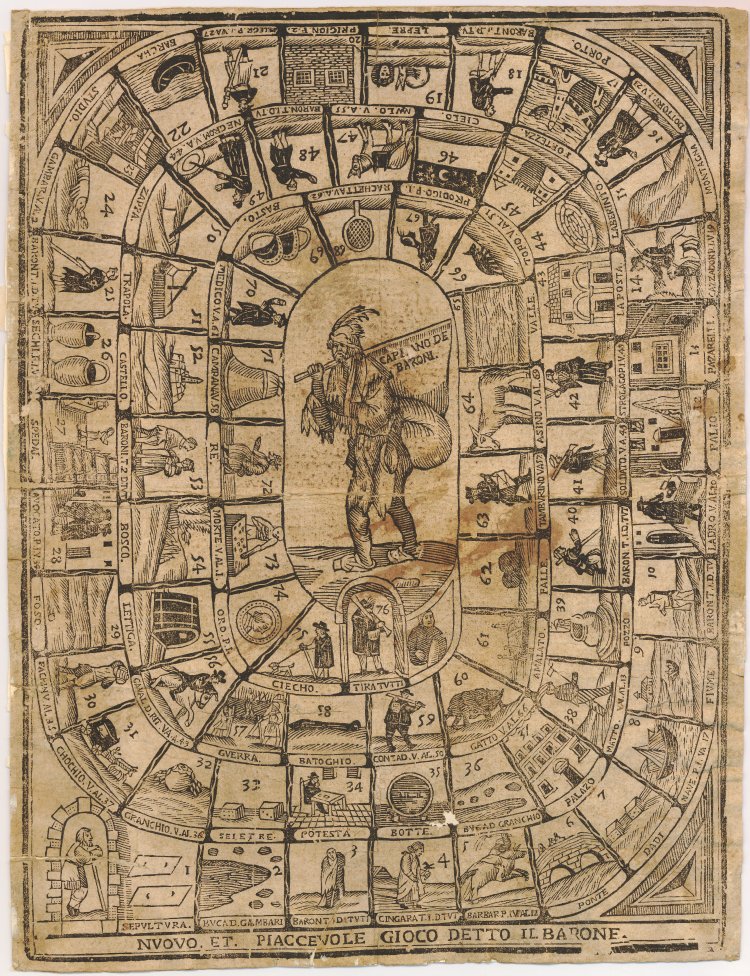
Nuovo et Piacevole Gioco detto il Barone
(?The baron’s new and pleasant game)
Anonymous woodcut printed board game from the second half of the 16th century, featuring a rustic military figure in the centre carrying a flag inscribed “Capitano di Baroni”.
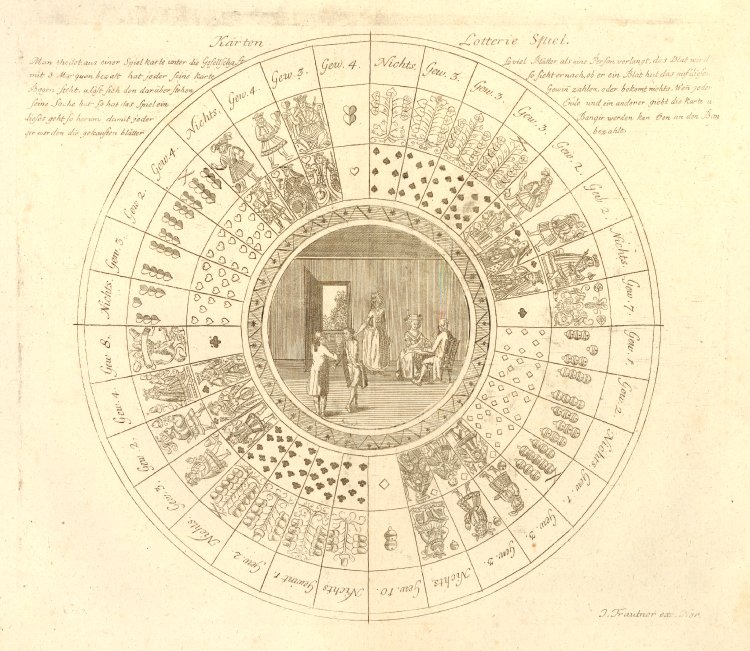
Karten Lotterie Spiel
(Lottery tickets)
Johann Trautner made this print between about 1700 and 1710. The circular game-board has three concentric rings, each divided into 32 compartments: the outer ring contains instructions; the next ring shows pictorial representations of playing cards which appear in their regular form in the inner ring, all surrounding a central domestic scene.
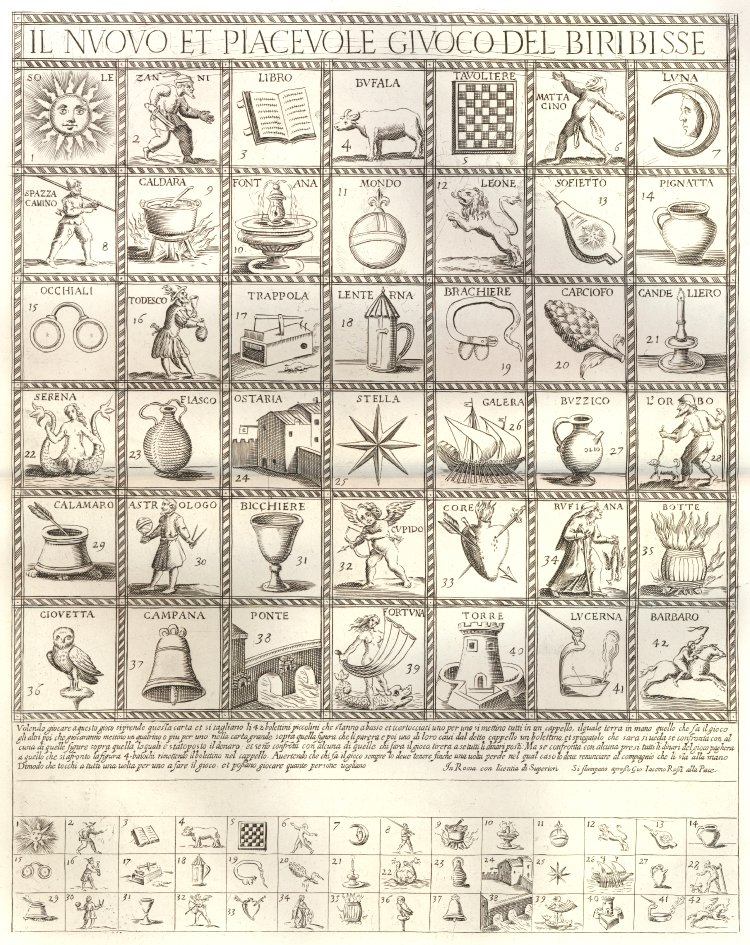
Il Nuovo et Piacevole Giuoco del Biribisse
(The new and pleasant game of biribisse)
Etching published by Giovanni Giacomo de’ Rossi between 1640 and 1690. The game board has numbered pictorial compartments of animals, objects and characters, repeated in smaller equivalent squares below the rules of the game.
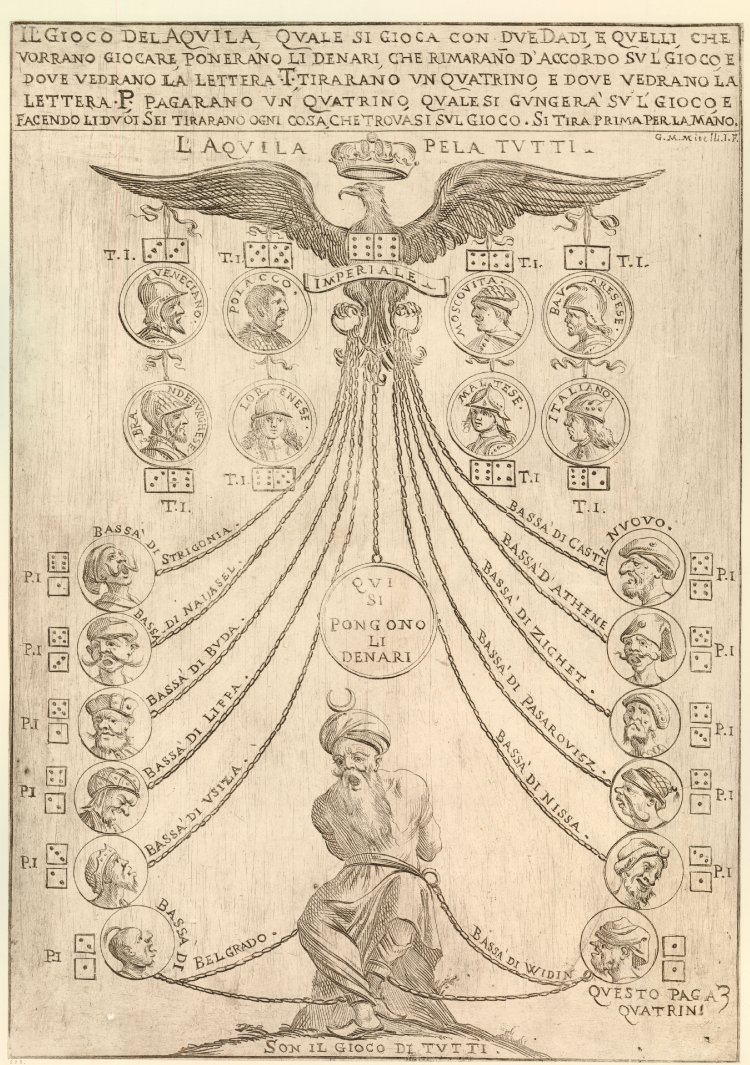
Il gioco del aquila
(The game of the eagle)
Etching print made by Giuseppe Maria Mitelli in the 1680s. The Imperial Eagle, surrounded by medallions depicting commanders, holds chains in its talons attached to defeated Turks.
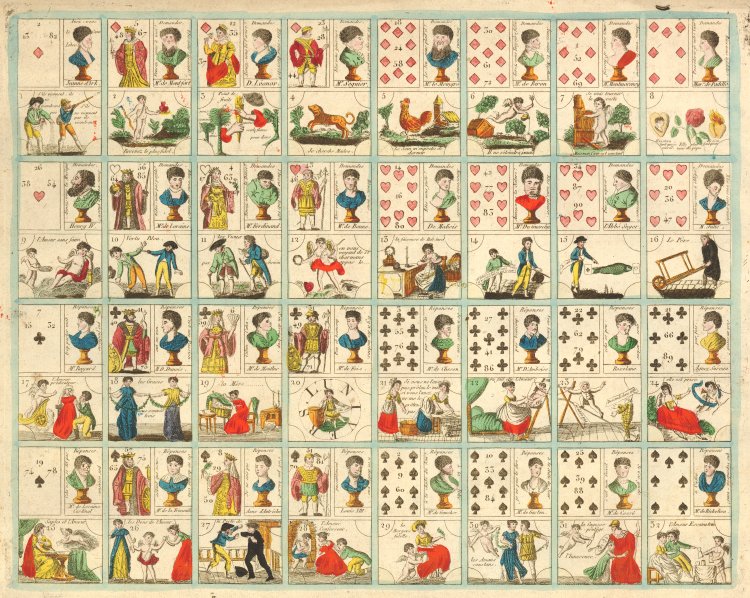
Grand jeu du nouveau testament avec 120 figures
(Great game of the New Testament with 120 figures)
I recall this etching from 1800 was accompanied by two other similarly ‘busy’ sections and the complete print appears to offer three different games in the single layout. Nothing evokes the prospect of commercial success quite like the combination of religion, education and gambling.
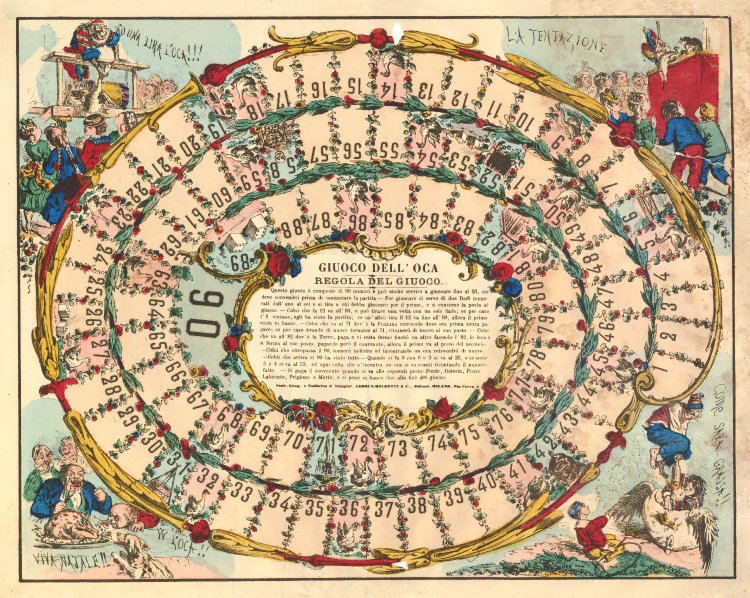
Giuoco dell’ Oca
(Game of the Goose)
An 1872 Italian lithograph published by Lebrun-Boldetti & co with a goose in each corner in a compromising position.

German print – game-board
Untitled anti-British World War II propaganda shipping race board game published by F Westenberger in about 1940.
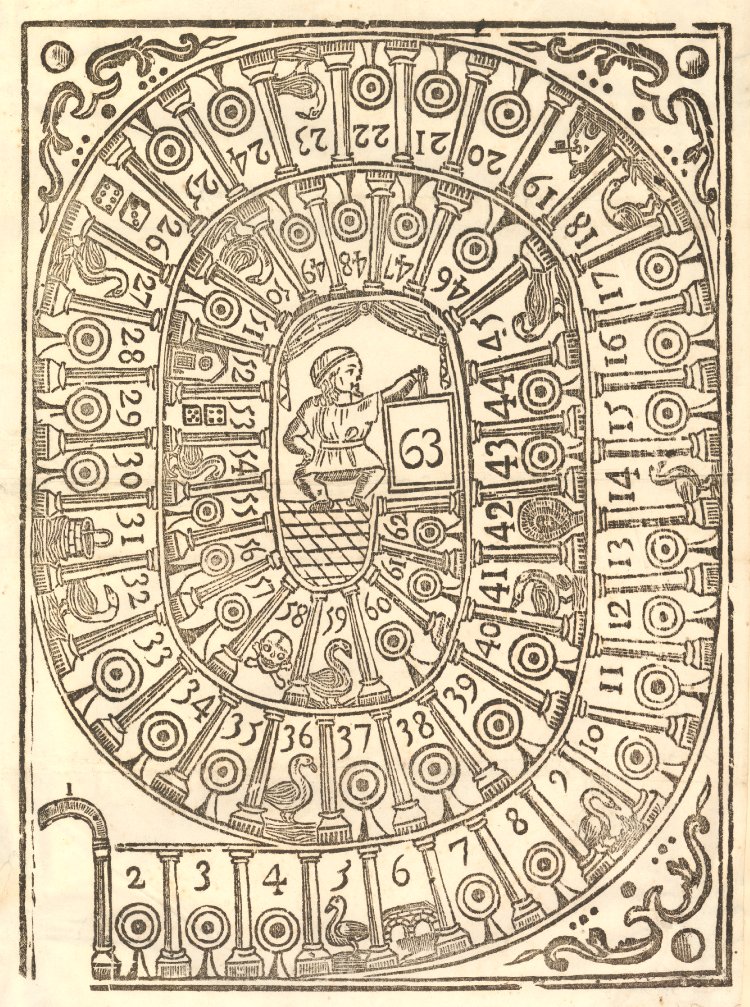
Game of the Goose
Simplistic spiral arrangement of game squares in an anonymous board produced in the 1700s.

Filosofia cortesana de Alonso de Barros
Etching/engraving made by Mario Cartaro in Venice in 1588. The game squares, numbering up to 63, lead to the ships sailing in the centre of the board on the ‘sea of suffering’.

Die Steckenpferd Galloppade
(? The galloping hobbyhorse)
Game-board print by Johann Benedikt Wunder from the 19th century with 60 numbered compartments arranged in a spiral. Several compartments show various scenes, and a number of compartments show a hobby horse; the central compartment shows Minerva pointing at a folly (?), figures in each corner: top left, a child on a hobby horse waving a sword, top right an old man on a hobby horse also waving a sword, bottom right, a man with a searchlight, bottom left, a fool.
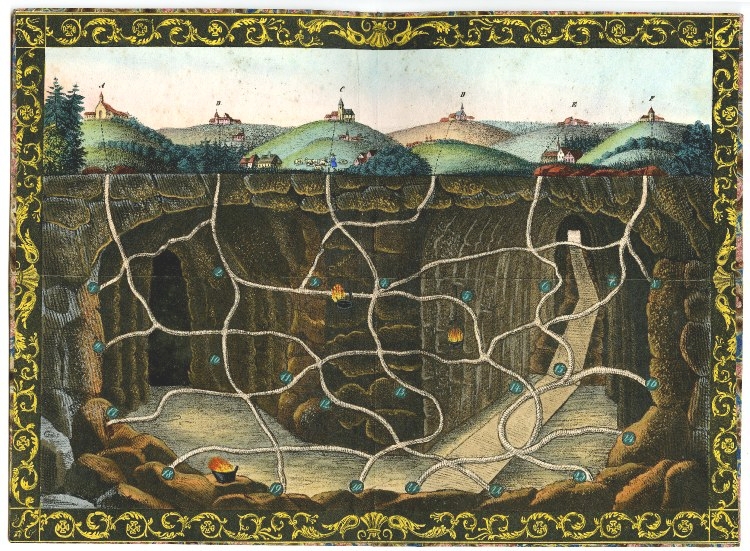
Der Bergbau
(The Working of Mines)
Hand-coloured lithograph, pasted onto marbled board from the mid-1800s. Game-board showing a cross-section of a mine and the network of tunnels leading down from 6 buildings, along the tunnels, various numbers which represent ore. Accompanied by 5 of an original 6 tokens in the form of miners, a rule sheet and an oblong box in which are small squares of glass, possibly originally used as counters. Kept in an embossed box with gold margins and bearing a printed label with an illustraion of a mine and the title in German, and beneath the lower margin, in French and English.
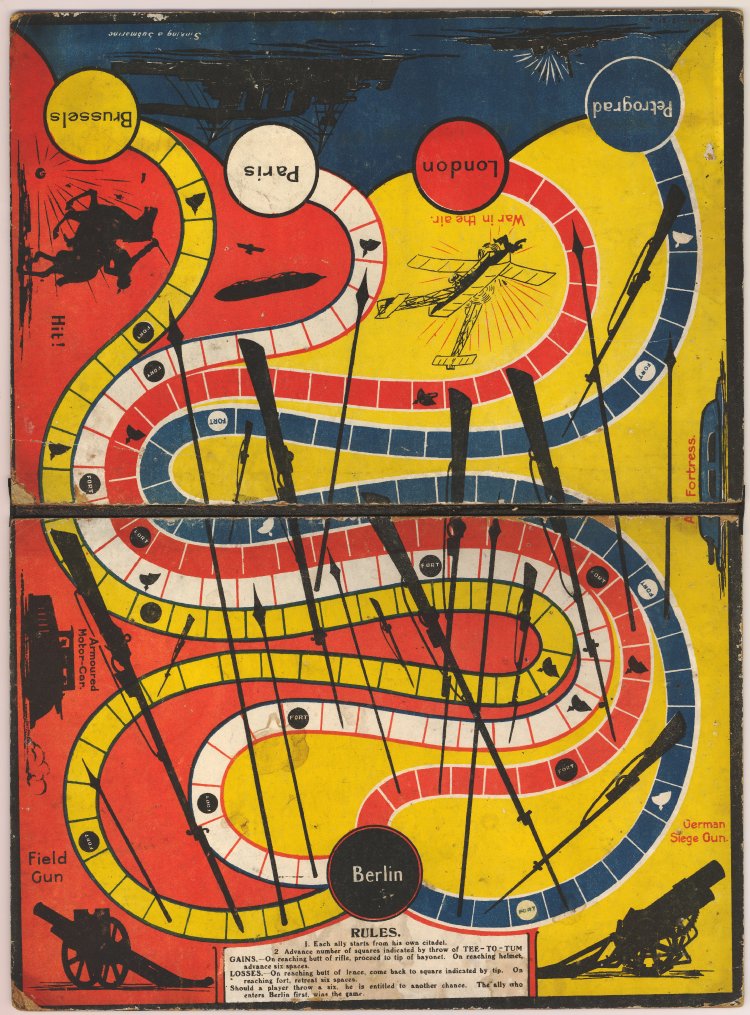
British print – game-board
Anonymous and untitled, this lithograph was published in the 1940s*. Notably absent from the curator’s notes are the terms ‘anti-German’ and ‘propaganda’. Just an observation.
*Brett points out in the comments that the figures depicted in this game print date to WWI and not WWII – the British Museum are changing their notes.
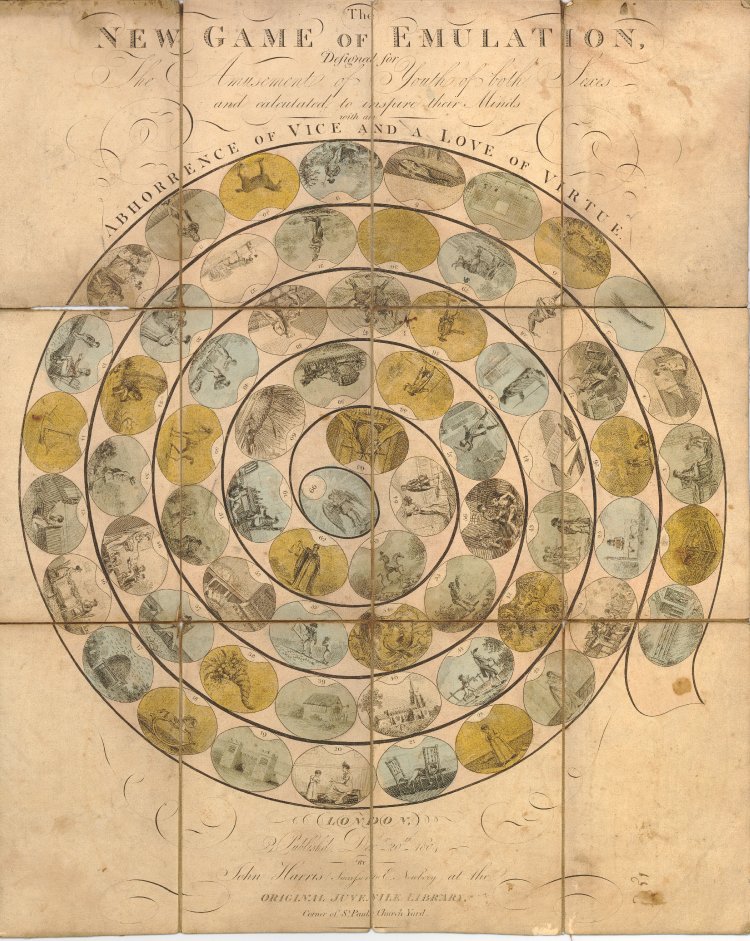
“The New Game of Emulation designed for
The Amusement of Youth of Both Sexes and
calculated to inspire their minds with an
Abhorrance of Vice and a Love of Virtue”
Linen-backed, hand-coloured etching, published by John Harris in London in 1804. Circular game-board with 66 numbered pictorial compartments, some illustrating moral scenes, the last compartment showing an angel.
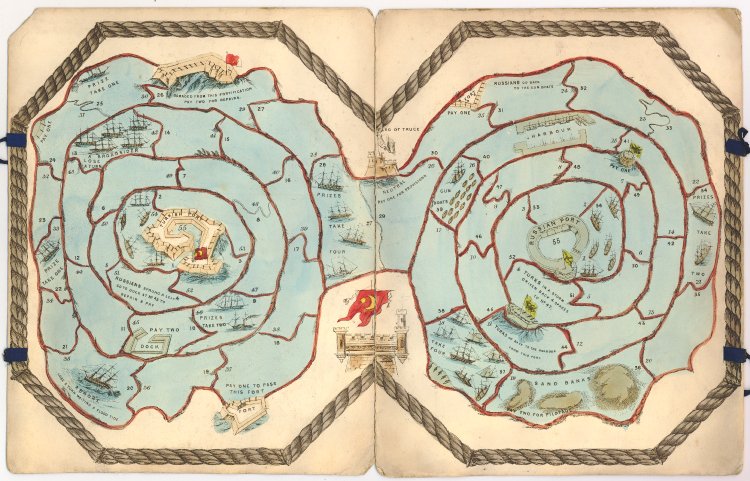
A New Game – Russia versus Turkey
Hand-coloured anonymous etching published in Paris (for the Englsh market) between 1875 and 1895. The folding game-board has 55 numbered compartments (numbered both forwards and in reverse) arranged in two rough spirals of water, each emanating from a port – the Turkish port on the left and the Russian on the right, with associated ships, harbours, forts and sandbanks.
Via : Paul K
Would you like to support Flashbak?
Please consider making a donation to our site. We don't want to rely on ads to bring you the best of visual culture. You can also support us by signing up to our Mailing List. And you can also follow us on Facebook, Instagram and Twitter. For great art and culture delivered to your door, visit our shop.






